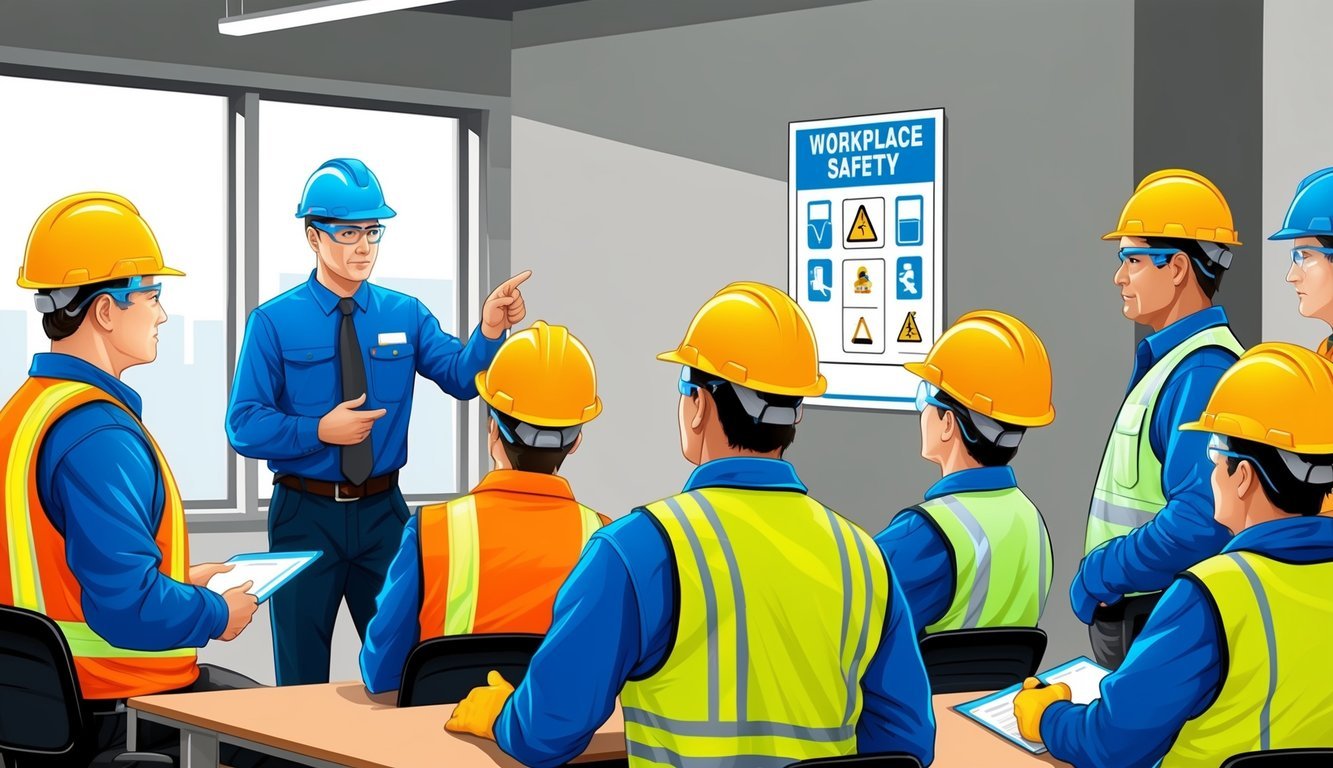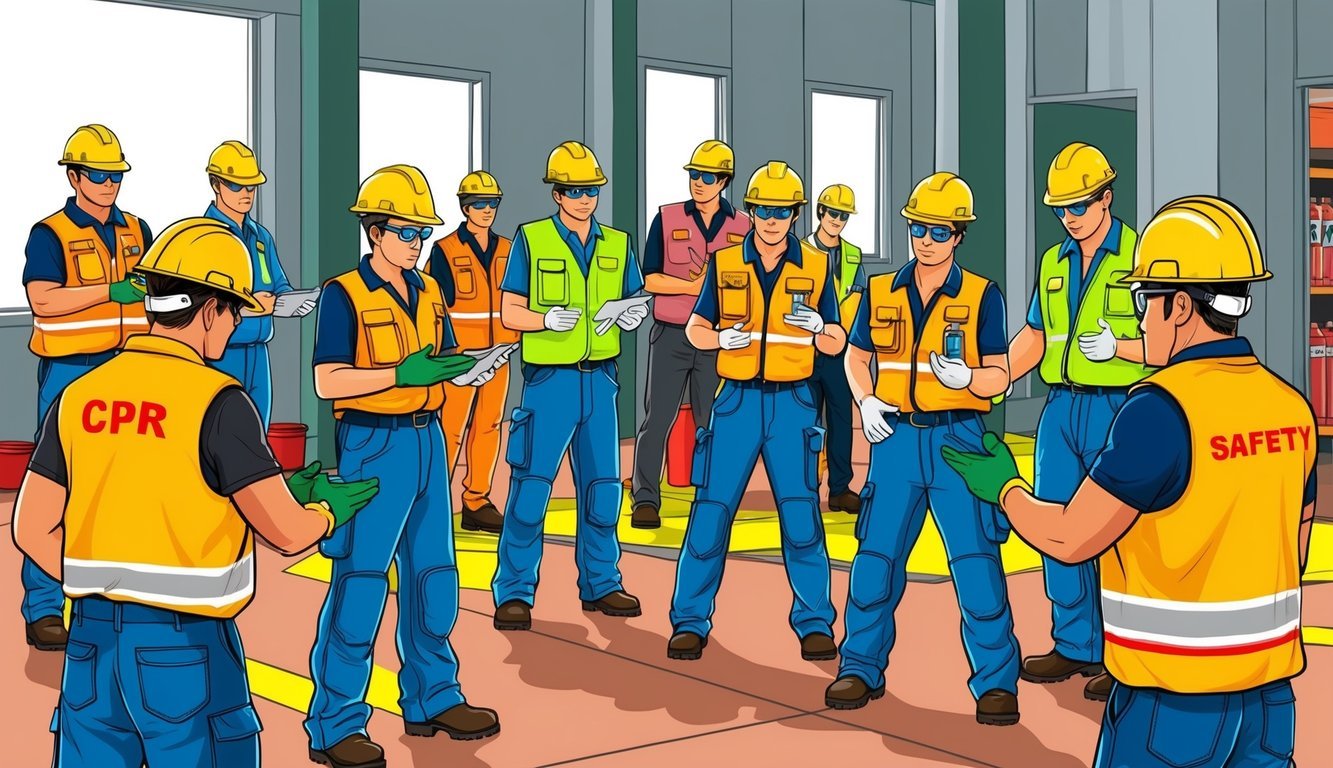“`xml
Keeping your workplace safe is a serious matter.
It’s not just about rules; it’s about protecting the folks you work alongside.
After all, nobody wants to deal with accidents or health issues on the job.
That’s why diving into safety training is super important.
Trust me, finding the right safety courses—either online or in person—can make all the difference.
Ready to become a safety whiz? Let’s go over some great courses available for workplace safety training!
1) OSHA 10-Hour Construction Training
Looking to get ahead in the construction world? The OSHA 10-Hour Construction Training course is a perfect fit.
It’s designed for those who are just starting out or anyone who wants to brush up on the essentials.
You’ll dive into the most common hazards—think falls and electrical mishaps—learning how to spot potential dangers and tackle them head-on.
You won’t just get bogged down with rules; you’ll pick up practical tips on using safety gear the right way and handling tools like a pro.
The cherry on top? You can learn from the comfort of your home.
No more boring classroom hours! Take it at your pace, whenever that fits into your busy life.
Once you complete the course, you’ll walk away with a card from the Department of Labor, proving you mean business when it comes to safety.
After all, keeping yourself and your coworkers safe in construction is essential.
This course gives you the skills to do just that.
2) Certified Safety Professional (CSP) Exam Prep
Ready to take your safety career to new heights? The Certified Safety Professional (CSP) exam is your ticket to becoming a top-notch safety expert.
This test covers everything you need to know to keep work environments safe and sound.
Just a heads up: you’ll need to pass the Associate Safety Professional (ASP) exam first unless you have other shiny certifications that might let you bypass it.
To prep, you’ve got plenty of options. ASSP offers some solid courses that tackle all the exam topics with a mix of lectures and hands-on problem-solving to ensure you’re really learning.
If you’re more of a self-starter, try ClickSafety’s online prep course.
It’s a flexible way to study when it works best for you.
Remember, passing that CSP exam isn’t just about the title.
It shows you know your stuff when it comes to workplace safety and can seriously boost your career!
3) First Aid/CPR/AED Training from Red Cross
Want to be the go-to person for emergencies at work? The Red Cross has your back with their First Aid/CPR/AED training.
This isn’t just about sitting in a classroom; you’ll actually learn how to manage injuries and sudden illnesses that might crop up on the job.
You’ll master how to perform CPR and use an AED—skills that can really save lives.
Plus, you’ll cover basic first aid for common workplace mishaps, like cuts and burns.
Whether you prefer hands-on classes or online learning, the Red Cross makes it easy and engaging.
They emphasize practice to help you remember what to do when the unexpected happens.
And this training isn’t just for healthcare workers; it’s a smart move for anyone wanting to ramp up their preparedness at work.
Plus, many jobs actually require this certification, so completing the course is a savvy career move.
Your shiny certificate will be valid for two years, and it meets OSHA standards, which your boss will appreciate.
4) NEBOSH International General Certificate

The NEBOSH International General Certificate is a fantastic option for managers or supervisors who have safety duties.
Even if you’re just launching your safety career, this course is a solid choice.
You’ll dive into vital safety topics relevant to workplaces worldwide, focusing on managing health and safety systems and assessing risks.
The knowledge you gain will help you effectively control workplace hazards.
This certification is trusted by a lot of big companies and can really make you stand out on the job market.
With a structured approach, you’ll learn step by step, allowing you to spot safety issues and suggest improvements that benefit everyone.
And hey, this certificate is recognized globally—perfect if you have your sights set on an international role.
Understanding Workplace Safety Regulations

Safety regulations in the workplace aren’t just boring rules; they’re essential to keeping everyone safe.
These guidelines help protect employees and save companies from fines and legal headaches.
Let’s break down why these guidelines matter and highlight a few key standards you should be aware of.
The Importance of Compliance
Following safety rules is crucial.
It safeguards you and your coworkers from unnecessary risks.
When everyone plays by the safety rules, the likelihood of accidents and injuries is significantly reduced.
Ignoring these regulations can lead to serious consequences for companies, including hefty fines or even shutdowns.
That’s why many businesses provide safety training courses for their employees.
When you know the rules, you also become a more astute observer of potential dangers.
You’ll be empowered to speak up if something feels off, making the workplace safer for all.
Common Safety Standards
While there are countless safety rules, some crop up more often than others.
Here are a few that you might encounter regularly:
- Wearing the appropriate safety gear, like hard hats or goggles
- Keeping workspaces neat to prevent trips and slips
- Using machines and tools correctly
- Knowing emergency protocols for fires or other crises
Different jobs have different rules.
For instance, construction sites enforce strict guidelines against working at heights, while factories may have specific protocols for handling chemicals.
Curious about more safety standards? OSHA training courses can introduce you to everything from safe lifting practices to addressing hazards you spot in the workplace.
Always remember, these regulations are there to protect you.
Understanding and adhering to them is vital in any job.
Benefits of Workplace Safety Training

Investing in safety training not only keeps everyone safe but also boosts morale.
It turns out teaching essential skills can prevent accidents and help employees feel valued.
Reducing Workplace Accidents
Safety training programs train employees to spot and avoid hazards.
You’ll learn how to properly use equipment and follow safety procedures, which helps minimize injuries and accidents on the job.
For instance, one tech company saw a whopping 30% reduction in repetitive strain injuries after they rolled out ergonomic training.
That’s impressive, right?
Knowing how to respond to accidents is equally important.
Having first aid skills and emergency protocols down can indeed save lives.
Quick action can really make a big difference when things go south.
Plus, safety courses keep you up-to-date with the latest regulations and best practices.
As workplaces evolve, so do safety needs.
Regular training ensures you’re always ahead of the curve.
Improving Employee Morale
When a company invests in safety training, it shows they care about their employees.
This commitment can make you feel more valued and secure in your job, which ultimately leads to a happier work environment.
Training builds confidence.
You’ll feel ready to tackle risky situations, and that confidence can spill over into your other work tasks.
Often, safety courses serve as a great team-building opportunity.
Working together on scenarios and drills can enhance communication and cooperation among coworkers, which can boost trust and problem-solving skills in high-pressure situations.
The best team-building courses focus on creating strong connections while reinforcing safety protocols—a recipe for a more effective team!
Knowing you’re in a safe workplace eases stress.
You can focus on your work without always worrying about potential hazards.
This clarity leads to better job satisfaction and productivity.
Frequently Asked Questions

Workplace safety training is essential for protecting workers and creating a healthy work environment.
Let’s tackle some common questions about these courses and best practices.
What are the top online courses for improving workplace safety?
Awesome options include the OSHA 10-Hour Construction Training, perfect for construction safety, and the Certified Safety Professional (CSP) Exam Prep course for those looking to get certified.
If you’re after life-saving skills, don’t miss the First Aid/CPR/AED Training from Red Cross—great for any workplace! And for a global perspective, check out the NEBOSH International General Certificate, covering essential safety management principles around the world.
Which OSHA course is considered the most beneficial for employees?
The OSHA 10-Hour Construction Training is often touted as the most beneficial for those in construction.
It covers the basics of workplace hazards, workers’ rights, and employer responsibilities.
If you’re in a non-construction setting, the OSHA 10-Hour General Industry course may be more your speed.
What are some key ergonomic training activities for office safety?
In ergonomic training, activities can include proper desk and chair setup exercises to avoid strain.
You could also learn how to adjust your monitor height and keyboard position for comfort.
Don’t overlook stretching routines for those long hours at the desk! They’re super important to ward off discomfort.
And practice sessions on lifting techniques can come in handy for moving boxes or office equipment.
Can you recommend some comprehensive safety and health training schedules?
A solid safety training schedule might look something like this: kick off with first aid in January, gear up for fire safety in February, focus on ergonomics in March, and so on.
Different topics each month keep things fresh.
Repeating the cycle annually can keep necessary knowledge up to date.
This kind of ongoing training is essential.
How can a safety officer improve their expertise through courses?
Safety officers can really shine by enrolling in the Certified Safety Professional (CSP) Exam Prep course, which covers a wide range of advanced safety topics.
Additionally, the NEBOSH International General Certificate is another fantastic choice to gain a broader understanding of global safety management.
Continuing education in specific areas like industrial hygiene or risk assessment is a bonus too!
What suggestions does OSHA have for making the workplace safer?
OSHA recommends regular safety inspections to identify and address hazards.
They also emphasize the need to provide thorough training for all workers.
Communication is key when it comes to safety policies.
Everyone should be aware of the rules and understand why they matter.
OSHA encourages involving employees in safety planning, too.
Often, team members have valuable insights for improving workplace safety based on their daily experiences.
“`
This version keeps the important information intact while presenting it in a warm, approachable, and engaging manner.

